Lesson 6: Linear Perception vs. Perceiving ‘Simultaneity’ (Image to Imagination)
The purpose of this section is to realize how words and imagery manipulate the perception of time as a teaching tool.
Western minds are generally conditioned to think in ‘action form’ through imagery and words – specifically in linear sequences where time appears to flow from the past to the future. The comic strip and a film strip both consist of ‘time flow’ action panels.

Writing in active voice and communicating via linear time-based images prevent your brain from perceiving two different physical phenomena that are actually the same event. It is difficult to understand this in words, so I’ll use images to convey these ideas.
Anyone knows two different things can occur simultaneously. For example, you can laugh while your little brother cries. Each is a different physical phenomenon and there’s no doubt they could occur at the same time.
It is difficult however, for the brain to perceive two different physical things that are actually the same event. In this case, the only way each physical thing can be shown to describe one event is if and only if they occur simultaneously. You have already been shown images that accomplished the task. You just haven’t been made conscious of what you’ve seen. Now is the time.
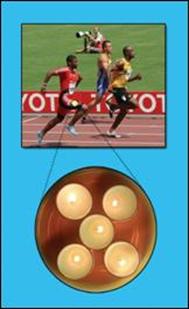
External movement of your whole body and unseen metabolic events in your muscle cells occur simultaneously. The two physical phenomena shown above (running and fermentation) do not occur separately with respect to time. The only way to see this is to ‘freeze time’ and show at least two images that actually represent the same event taken as a whole. Described more specifically in words, “What happens microscopically and unseen within the body’s cells at a specific moment synchronizes with its simultaneous but different physical-form.” To say each form or phenomenon is a different event is not correct because taken as a whole it is/they are the same event.
In other words, functional nutrition and physical movement occur simultaneously.
Hardly anyone thinks of nutrition as an event, in concrete terms. However, people often speak of ‘metabolism’ as an event that has a concrete outcome such as weight gain or weight loss. Such an outcome can only occur because functional nutrition is metabolism. Nutrition is an active event. (Duh! Duh – as in epiphany.) In all three cases below, you ‘see a cell’ fermenting carbohydrates joined to its other simultaneous external form, as seen by the naked eye. Keep in mind, resting must be considered as part of the whole.
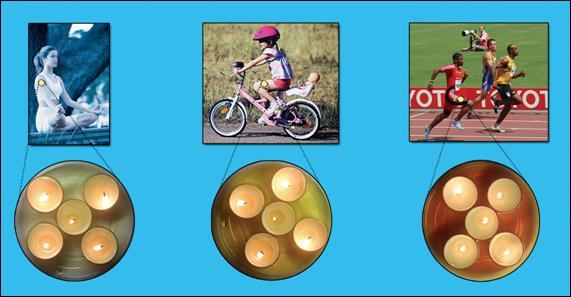
Perceiving simultaneity is not limited to just two forms; we feel other ‘simultaneous counterparts’ (e.g. pressure in joints, muscle tension, pain or exhilaration) as we experience the movement of our bodies or the release of stress that comes with deep breathing and the slowing of our heart rate. The image of the woman sitting peacefully captures such a moment in time.
If you have ever heard anyone say, “I can feel down to the cellular level”, then this lesson shows you how it is at least possible to begin connecting with your body in such a way. You can learn to feel your ligaments and tendons – safely – in such a manner that you are ‘your own MRI’. I will be teaching this later this semester. You want integrated education? You got it.
In short, either clumsy or athletically skilled movement occurs in concert with our ‘emotional content’ as well as chemical transformations of matter in the microscopic ‘cell space’ of muscles. See the beginning of Enter the Dragon with Bruce Lee to understand what I mean by emotional content. (or ask me)
Passive Voice vs. Active Voice, Imagery, and Conditioning
Usually, non-fiction writing calls for using ‘active voice’. But Passive voice should sometimes be used deliberately as a device to ‘force’ the reader to focus solely on an object, as opposed to a person or thing taking action and imposing change upon an object. For example, earlier I wrote in passive voice, “Acid is always created in a cell” as opposed to, “Cells always create acid” (active voice). I wanted you to focus on acid, not on the cell taking action. Consider this in light of a ‘quick and dirty tip’ from a teacher on the topic of using passive voice vs. active voice, “One clue that your sentence is passive is that the subject isn’t taking a direct action.” (Mignon Fogarty, Grammar Girl)
Active voice (or a comic strip) presents a ‘problem’ when the purpose is to focus on two physical phenomena that must be shown to happen simultaneously. For example, I could write, “Muscle cells ferment carbohydrates into acids as the runners sprint down the track.” You may understand this now, but this would not make much sense to a person who has not yet learned each piece of the whole, as shown in the earlier sections of this book. I sometimes used passive voice and imagery to force focus on each object independently. Passive voice and imagery work together; each portray simultaneity and freeze time. The image below ‘freezes time’. When we ‘freeze time’ no action is taking place, there is only the sense of what ‘is’ or things as they ‘are’.
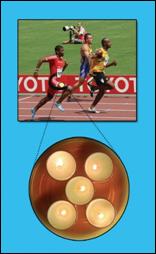
In short, passive voice mirrors the way our brains hold an image. People who like mysteries do not mind the use of passive voice, because it leaves a person hanging on the image, remaining clueless of who or what acted upon the object. Patient curiosity trumps frenetic impatience. Conversely, action based writing, e.g. Russell Wilson scrambles, evades a sack, throws on the run deep downfield to Percy Harvin, Harvin leaps for the ball and runs in for the TD” are moving images of thought like a film strip. Without question, images that make ‘time appear’ makes it impossible to imagine ‘simultaneity’ of two different phenomena.
Without knowing it, our brains are conditioned by linear-time action sequences.
Fortunately, we can condition our brains to use words and imagery to imagine ‘simultaneity’. This is harder for many Western people but not Japanese people because they are culturally conditioned from an early age by images that depict simultaneity from a young age; (see references and my remarks soon below on this thought).
You Can’t Imagine Unless You Activate Your Image-In. (Imagination)
By using words and imagery ‘passively’ I am often showing you to not think (but to just perceive and develop an imagination, Image-I-Nation) Rhetorical question: Do you recall ever being told or saying, “Learn it by Heart”. Clearly, this is a level that indicates we know something so well we don’t have to think about how do it or we recall the meaning or definition of something instantly.
Just as there is no need to think after you master the mechanics of a dead lift, singing a song, serving a tennis ball, using a stick-shift, or playing a musical instrument, once you know what a complex image shows, there is no need to think. Recall the advice and the purpose of Video 1: Image Imprinting, “I don’t want you to think, I want you to see, just watch the video.”
Even though the images in this video transitioned quickly – they were not depicting a linear series of images to tell a story – but flashed single images, which are used in this book/class/seminar to synthesize a greater coherent whole. Connecting images you know by heart, stored in your head, is a way to develop a slower, but more powerful reasoning ability. As you read or come across new information your brain automatically ‘conjures up’ images connected to the new ‘bit’. But you have to know what the ‘bits of the whole’ represent in order to build the ever greater picture. I suggest you draw by hand to anchor your ability to hold images and cement what you learn more deeply.
Developing an imagination (the ability to picture things concretely) enables you to ‘see connections’ of phenomena occurring outside of the body in nature with ‘health phenomena’ occurring in the body. For example, the yellowing of the bleu cheese dressing shown below shows oxygen combined with the unsaturated fatty acids in the soybean oil. The whiter area was enclosed away from air (inside the turned upside down jar) but the part that yellowed was exposed to air (oxygen) and so oxidized overnight as it sat on my counter top!

The yellowing you see resulted from a free radical chain reaction, which occurs readily to unsaturated fats in both food and in your body. Polyunsaturated fats like fish oil, flax-seed oil, and walnut oil are especially vulnerable to this yellowing effect and therefore harmful to the body in technical terms, i.e. oxidative stress and free radical chain reactions. The only way for oil based paint to dry and produce a quality varnish is IF they are unsaturated fats. Saturated fats by definition are stable and not prone to oxidation, yellowing, or varnishing.
If you take anti-oxidants, you are trying to prevent oxidation or free radical chain reactions from destroying your cell membranes, similar to the image above where only the outer edge was ‘destroyed’. Moreover, this picture below explains why taking a purported healthy product like fish oil as a way to promote something ‘good’ is a great example of jamming a ‘bit of something that is true’ into a larger incorrect medical model. Yes it’s true that fish oil is anti-inflammatory, which = the true bit. But there’s a reason ‘overall’ why this effect is ‘not good’ in the long run.
Developing and synthesizing an image base enables you to integrate knowledge within your head. However, there are two points to remember:
Point 1: You just saw an example of a harmful chemical reaction that happens in your body and in nature.
Point 2: It is crucial each ‘small picture’ (bit of information) is based on correct knowledge in order to avoid a structure of thinking (a theory) that is invalidated by an incorrect bit.
Comics, Communication, and Cultural Conditioning
I am aware of the enormous difficulty to describe and conceive ‘simultaneity’. The way images are presented in the USA (and many others) conditions all of us to perceive time and action in a certain way. I suggest reading Understanding Comics by Scott McCloud if you want to wrap your head around this more completely. Below: excerpt to the McCloud link.
- Understanding Comics received praise from notable comic and graphic novel authors such as Art Spiegelman, Will Eisner, Alan Moore, Neil Gaiman and Garry Trudeau (who reviewed the book for the New York Times), and was called “one of the most insightful books about designing graphic user interfaces ever written” by Apple Macintosh co-creator Andy Hertzfeld.[1]
Naturally, McCloud presents the ‘simultaneity concept’ in comic form to describe art, communication, and perception in his book. He shows examples of how the Japanese in particular express multiple images that reflect ‘simultaneity’ more often than any other culture. McCloud did not use the word ‘simultaneity’ – this author takes credit for this -Whoop dee ding and yippee kai-yay for me.
Keep in mind, the illustrations you see throughout this course show the ‘simultaneity’ of micro and macro events. Physics, art, medical science, and nutrition go hand in hand. Physiology is physics and art, and art is communication. I actually draw the concept of ‘action based linear perception vs. ‘perception of simultaneity’ in front of live audiences when it’s practical to do so. Many early physicians were artists. See Ray Peat’s article Painter Science on this topic!
Studies of Embryos by Leonardo da Vinci (Pen over red chalk 1510-1513)
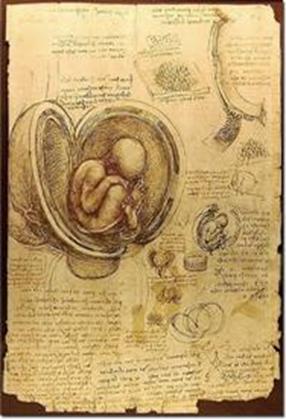
Art not only simplifies health, nutrition and physical training science, but may be used to present metabolism as ‘it’ actually is – one event occurring simultaneously – as opposed to sets of incoherent, separate phenomena. Visualizing spaces within the body – compartmentalizing it – similarly to visualizing the location and separation of objects within in a space in your home such as your bedroom must be an ability you develop if you want to master just the basics of health, nutrition, and exercise science.
A lot of details about nutrition, physiology, and health can be learned from a single schematic showing the pathway food and oxygen take to get into the blood, and then to muscles – as depicted below in a schematic titled: “The Anatomy of Food and Oxygen Delivery”. (Lesson 8 from The Physical Rules by this author)
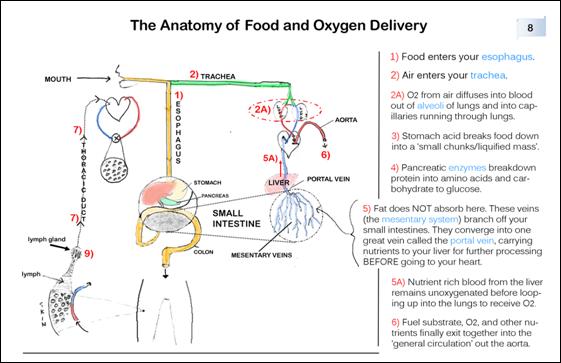

Enjoyed reading the article above, actually explains everything in detail,the guide is very interesting and
effective.
King regards,
Demir Hessellund